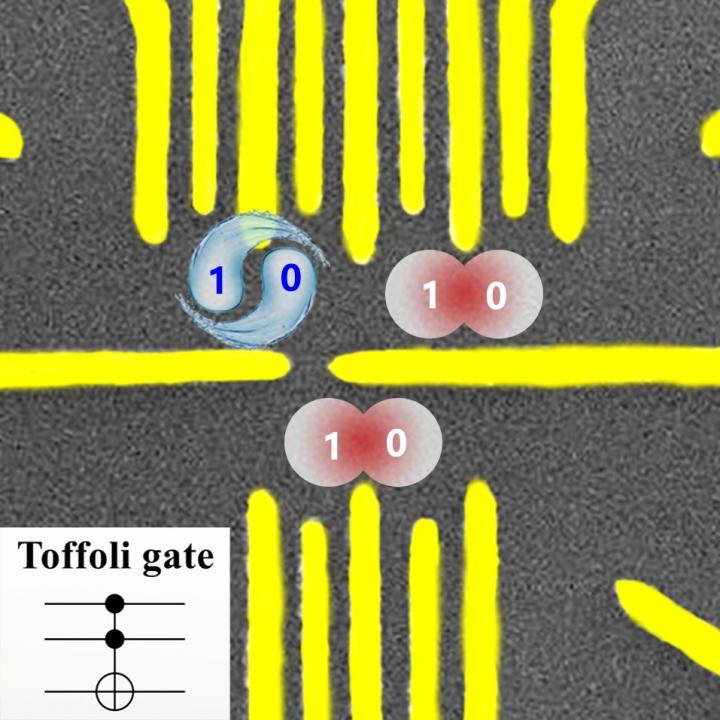Experimentally demonstrated a toffoli gate in a semiconductor three-qubit system

This is the Toffoli Gate in a three-qubit system. Credit: University of Science and Technology of China
This is the first time for the realization of the Toffoli gate in the semiconductor quantum dot system, which motivates further research on larger scale semiconductor quantum processor. The result was published as 'Controlled Quantum Operations of a Semiconductor Three-Qubit System ' (Physical Review Applied 9, 024015 (2018)).
Developing the scalable semiconductor quantum chip that is compatible with modern semiconductor-techniques is an important research area. In this area, the fabrication, manipulation and scaling of semiconductor quantum dot based qubits are the most important core technologies.
Professor GUO Guoping's group aims to master these technologies and has been devoted to this area for a long time. Before the demonstration of the three-qubit gate, they have realized ultrafast universal control of the charge qubit based on semiconductor quantum dots in 2013(Nature Communications. 4:1401 (2013)), and achieved the controlled rotation of two charge qubits in 2015(Nature Communications. 6:7681 (2015)).
The Toffoli gate is a three-qubit operation that changed the state of a target qubit conditioned on the state of two control qubits. It can be used for universal reversible classical computation and also forms a universal set of qubit gates in quantum computation together with a Hadamard gate.
Furthermore, it is a key element in quantum error correction schemes. Implementation of the Toffoli gate with only single- and two-qubit operations requires six controlled-NOT gates and ten single-qubit operations.
As a result, a single-step Toffoli gate can reduce the number of quantum operations dramatically, which can break the limit of coherence time and improve the efficiency of quantum computing. Researchers from Guo's group found the T-shaped six quantum dot architecture with openings between control qubits and the target qubit can strengthen the coupling between qubits with different function and minimize it between qubits with the same function, which satisfies the requirements of the Toffoli gate well.
Using this architecture with optimized high frequency pulses, researchers demonstrated the Toffoli gate in semiconductor quantum dot system in the world for the first time, which paves the way and lays a solid foundation for the scalable semiconductor quantum processor.
The reviewer spoke highly of this work, and thought this is an important progress in the field of semiconductor quantum dot based quantum computing.”The work is detailed and clearly demonstrates a high level of experimental technique and would be of high interest to people working in the field of electrostatically defined quantum dots for quantum computation”.
Media Contact
All latest news from the category: Information Technology
Here you can find a summary of innovations in the fields of information and data processing and up-to-date developments on IT equipment and hardware.
This area covers topics such as IT services, IT architectures, IT management and telecommunications.
Newest articles

Superradiant atoms could push the boundaries of how precisely time can be measured
Superradiant atoms can help us measure time more precisely than ever. In a new study, researchers from the University of Copenhagen present a new method for measuring the time interval,…

Ion thermoelectric conversion devices for near room temperature
The electrode sheet of the thermoelectric device consists of ionic hydrogel, which is sandwiched between the electrodes to form, and the Prussian blue on the electrode undergoes a redox reaction…

Zap Energy achieves 37-million-degree temperatures in a compact device
New publication reports record electron temperatures for a small-scale, sheared-flow-stabilized Z-pinch fusion device. In the nine decades since humans first produced fusion reactions, only a few fusion technologies have demonstrated…





















